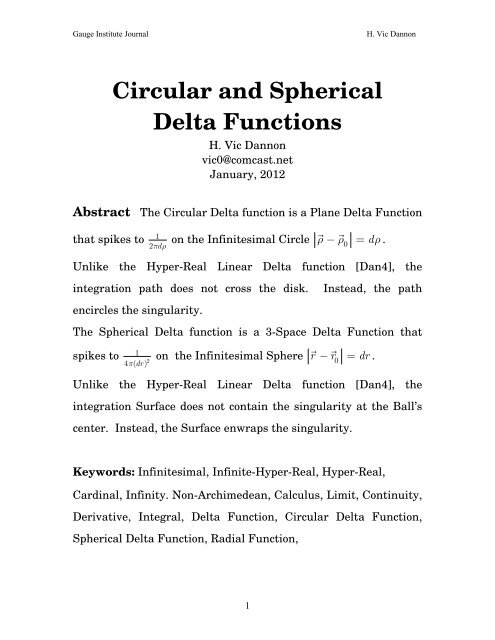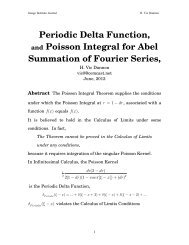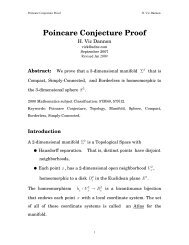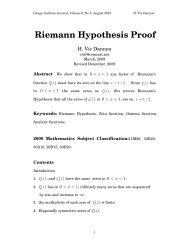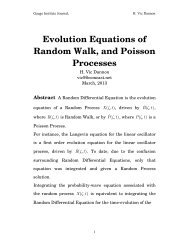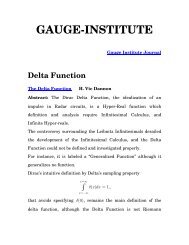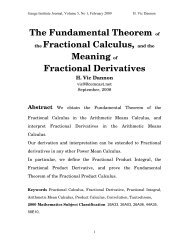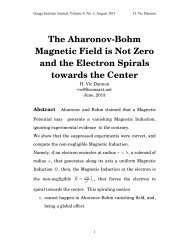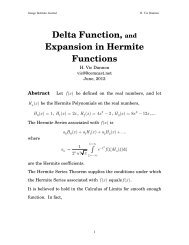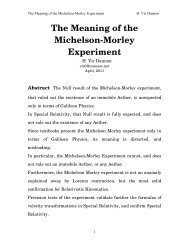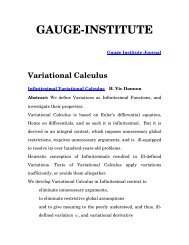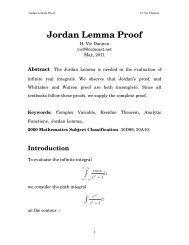Circular and Spherical Delta Functions - Gauge-institute.org
Circular and Spherical Delta Functions - Gauge-institute.org
Circular and Spherical Delta Functions - Gauge-institute.org
You also want an ePaper? Increase the reach of your titles
YUMPU automatically turns print PDFs into web optimized ePapers that Google loves.
<strong>Gauge</strong> Institute JournalH. Vic Dannon2000 Mathematics Subject Classification 26E35; 26E30;26E15; 26E20; 26A06; 26A12; 03E10; 03E55; 03E17; 03H15;46S20; 97I40; 97I30.ContentsIntroduction1. Hyper-real Line2. Hyper-real Plane3. Hyper-real Integral4. <strong>Delta</strong> Function5. δρ ( ρ0) δφ ( φ0− − )6. <strong>Circular</strong> <strong>Delta</strong> Function δ Circle( ρ )7. Circulation of <strong>Circular</strong> <strong>Delta</strong>8. Sifting by δ Circle( ρ )9. Representing f ( ρ )10. δ( r −r0) δ( θ −θ0) δ(φ−φ0)11. <strong>Spherical</strong> <strong>Delta</strong> Function δ Sphere( r )12. Surface Circulation of δ Sphere( r )13. Sifting by δ Sphere( r )2
<strong>Gauge</strong> Institute JournalH. Vic Dannon14. Representing f () r15. r r0 0 0δ( − ) δ( θ −θ ) δ( φ−φ ) δ(α−α0)16. 3-<strong>Spherical</strong> <strong>Delta</strong> Function δ 3-Sphere ( r )References3
<strong>Gauge</strong> Institute JournalH. Vic DannonIntroductionThe product of two <strong>Delta</strong> functions on the line,δ( x −x ) δ(y − y )0 0isa Plane <strong>Delta</strong> Function that spikes atto the infinite Hyperrealnumber1. dxdy( x , y )0 0But the Hyper-real plane allows encircling a singular point of adifferent <strong>Delta</strong> Function, along an infinitesimal circle centered at ρ = ρ 0, in order to pick a function value at ρ = ρ 0.That <strong>Delta</strong> Function is the <strong>Circular</strong> <strong>Delta</strong> function that is definedon the Hyper-real Plane.The <strong>Circular</strong> <strong>Delta</strong> Function spikes on the Infinitesimal Circle ρ − ρ = ρ0d1to the hyper-real number , <strong>and</strong> vanishes2πdρ elsewhere, including the singular point ρ = ρ 0.Unlike the Hyper-Real Linear <strong>Delta</strong> function [Dan4], theintegration path does not cross the Infinitesimal disk. Instead,the path encircles the singularity.We use the <strong>Circular</strong> <strong>Delta</strong> with the 2 ndGreen’s identity torepresent a symmetrically radial function f ( ρ ) in the Hyper-realplane.In 3-Space, the product of three <strong>Delta</strong> functions on the line,δ( x −x ) δ( y −y ) δ(z −z0)0 0is a <strong>Delta</strong> Function that spikes at4
<strong>Gauge</strong> Institute JournalH. Vic Dannon1( x0, y0, z0), to the infinite Hyper-real number . dxdydz3-Space allows avoiding a singular point of a different <strong>Delta</strong>Function, by wrapping around it an infinitesimal sphere centered at r = r 0, in order to pick a function value at r = r 0.That <strong>Delta</strong> Function is the <strong>Spherical</strong> <strong>Delta</strong> function that is definedon the Hyper-real 3-Space.The <strong>Spherical</strong> <strong>Delta</strong> Function spikes on the Infinitesimal Sphere r − r = d1r, to the Hyper-real , <strong>and</strong> vanishes elsewhere,20 including the singular point r = r 0.4 π( dr )Unlike the Hyper-Real Linear <strong>Delta</strong> function [Dan4], theintegration Surface does not contain the singularity at theInfinitesimal Ball’s center. Instead, the Surface enwraps thesingularity.We use the <strong>Spherical</strong> <strong>Delta</strong> with the 2 ndGreen’s identity torepresent a symmetrically radial function f () r in the Hyper-real3-Space.5
<strong>Gauge</strong> Institute JournalH. Vic Dannon1.Hyper-real LineEach real number α can be represented by a Cauchy sequence ofrational numbers, ( r , r , r ,...) so that r → α .1 2 3The constant sequence ( ααα , , ,...) is a constant hyper-real.In [Dan2] we established that,1. Any totally ordered set of positive, monotonically decreasingnto zero sequencesinfinitesimal hyper-reals.( ι1, ι2, ι3,...)constitutes a family of2. The infinitesimals are smaller than any real number, yetstrictly greater than zero.1 1 13. Their reciprocals ( , , ,...ι 1ι 2ι 3) are the infinite hyper-reals.4. The infinite hyper-reals are greater than any real number,yet strictly smaller than infinity.5. The infinite hyper-reals with negative signs are smallerthan any real number, yet strictly greater than −∞.6. The sum of a real number with an infinitesimal is anon-constant hyper-real.7. The Hyper-reals are the totality of constant hyper-reals, afamily of infinitesimals, a family of infinitesimals with6
<strong>Gauge</strong> Institute JournalH. Vic Dannonnegative sign, a family of infinite hyper-reals, a family ofinfinite hyper-reals with negative sign, <strong>and</strong> non-constanthyper-reals.8. The hyper-reals are totally ordered, <strong>and</strong> aligned along aline: the Hyper-real Line.9. That line includes the real numbers separated by the nonconstanthyper-reals. Each real number is the center of aninterval of hyper-reals, that includes no other real number.10. In particular, zero is separated from any positive realby the infinitesimals, <strong>and</strong> from any negative real by theinfinitesimals with negative signs, −dx .11. Zero is not an infinitesimal, because zero is not strictlygreater than zero.12. We do not add infinity to the hyper-real line.13. The infinitesimals, the infinitesimals with negativesigns, the infinite hyper-reals, <strong>and</strong> the infinite hyper-realswith negative signs are semi-groups withrespect to addition. Neither set includes zero.14. The hyper-real line is embedded in , <strong>and</strong> is not ∞homeomorphic to the real line. There is no bi-continuousone-one mapping from the hyper-real onto the real line.7
<strong>Gauge</strong> Institute JournalH. Vic Dannon15. In particular, there are no points on the real line thatcan be assigned uniquely to the infinitesimal hyper-reals, orto the infinite hyper-reals, or to the non-constant hyperreals.16. No neighbourhood of a hyper-real is homeomorphic toan nball. Therefore, the hyper-real line is not a manifold.17. The hyper-real line is totally ordered like a line, but itis not spanned by one element, <strong>and</strong> it is not one-dimensional.8
<strong>Gauge</strong> Institute JournalH. Vic Dannon2.Hyper-real PlaneThe Hyper-real Plane is a cross product of two Hyper-real lines.Each 2-vector of real numbers ( αβ) , can be represented by aCauchy sequence of rational numbers,( r1, q1),( r2, q2),( r3, q3)...sothat ( rn, qn ) → ( αβ , ) .The constant sequence ( αβ , ),( αβ , ),( αβ , )... is a constant hyper-real2-vector.In [Dan2] we established that,1. Any totally ordered set of positive, monotonically decreasingto (0, 0) sequences of 2-vectors ( ι1, ο1)( ι2, ο2),( ι3, ο3)...constitutes a family of infinitesimal hyper-real 2-vectors.2. The infinitesimal 2-vectors are smaller than any real 2-vector, yet strictly greater than the zero 2-vector.3. Their reciprocals1 1 1 1 1 1( , ),( , ),( , ),...ι ο ι ο ι ο1 1 2 2 3 3are the infinitehyper-real 2-vectors.4. The infinite hyper-real 2-vectors are greater than any real 2-vector, yet strictly smaller than the infinity 2-vector.9
<strong>Gauge</strong> Institute JournalH. Vic Dannon5. The infinite hyper-real 2-vectors with negative signs aresmaller than any real 2-vector, yet strictly greater than( −∞,−∞) .6. The sum of a real 2-vector with an infinitesimal 2-vector is anon-constant hyper-real 2-vector.7. The Hyper-real 2-vectors are the totality ofa. constant hyper-real 2-vectors,b. a family of infinitesimal 2-vectors, with signs that maybe ( ++ , ), ( +− , ), ( −+ , ), or ( −− , ),c. a family of infinite hyper-real 2-vectors with signs thatmay be ( ++ , ), ( +− , ), ( −+ , ), or ( −− , ), <strong>and</strong>d. non-constant hyper-real 2-vectors.8. The hyper-real 2-vectors constitute the Hyper-real Plane.9. That plane includes the real 2-vectors separated by the nonconstanthyper-real 2-vectors. Each real 2-vector is thecenter of a disk of infinitesimal radius of hyper-real 2-vectors, that includes no other real 2-vector.10. In particular, the zero 2-vector is separated from anyreal 2-vector by infinitesimal 2-vectors that lie in a disk ofinfinitesimal radius around the zero.11. The Zero 2-vector is not an infinitesimal 2-vector,because zero is not strictly greater than zero.10
<strong>Gauge</strong> Institute JournalH. Vic Dannon12. We do not add the infinity 2-vector to the hyper-realPlane.13. The infinitesimal 2-vectors, <strong>and</strong> the infinite hyper-real2-vectors, are semi-groups with respect to addition. Neitherset includes zero.∞ × ∞14. The hyper-real Plane is embedded in , <strong>and</strong> isnot homeomorphic to the real Plane. There is no bicontinuousone-one mapping from the hyper-real Plane ontothe real plane.15. In particular, there are no points in the real Plane thatcan be assigned uniquely to the infinitesimal hyper-real 2-vectors, or to the infinite hyper-real 2-vectorss, or to the nonconstanthyper-real 2-vectors.16. No neighbourhood of a hyper-real 2-vector isn ×nhomeomorphic to an ball. Therefore, the hyperrealplane is not a manifold.17. The hyper-real plane is not spanned by two elements,<strong>and</strong> it is not two-dimensional.11
<strong>Gauge</strong> Institute JournalH. Vic Dannon3.Hyper-real IntegralIn [Dan3], we defined the integral of a Hyper-real Function.Let f () x be a hyper-real function on the interval [ ab] , .The interval may not be bounded.f () x may take infinite hyper-real values, <strong>and</strong> need not bebounded.At eacha≤x≤b,there is a rectangle with basedx dx[ x − , x + 2], height f () x , <strong>and</strong> area2f ( xdx. )We form the Integration Sum of all the areas for the x ’s thatstart at x = a, <strong>and</strong> end at x = b,∑ f ( xdx ) .x∈[ a, b]If for any infinitesimal dx , the Integration Sum has the samehyper-real value, then f () x is integrable over the interval [ ab] , .Then, we call the Integration Sum the integral of f () x from x = a,to x= b, <strong>and</strong> denote it by12
<strong>Gauge</strong> Institute JournalH. Vic Dannonx=b∫ f ( xdx ) .x=aIf the hyper-real is infinite, then it is the integral over [, ab] ,If the hyper-real is finite,x=b∫ fxdx ( ) = real part of the hyper-real . x=a3.1 The countability of the Integration SumIn [Dan1], we established the equality of all positive infinities:We proved that the number of the Natural Numbers,Card , equals the number of Real Numbers,2 Card Card = , <strong>and</strong>we have2 Card2Card Card = ( Card) = .... = 2 = 2 = ... ≡ ∞.In particular, we demonstrated that the real numbers may bewell-ordered.Consequently, there are countably many real numbers in theinterval [ ab] , , <strong>and</strong> the Integration Sum has countably many terms.While we do not sequence the real numbers in the interval, thesummation takes place over countably many f ( xdx. )13
<strong>Gauge</strong> Institute JournalH. Vic DannonThe Lower Integral is the Integration Sum where f ( x ) is replacedby its lowest value on each interval3.2∑x∈[ a, b]⎛⎜⎝dx dx2 2[ x − , x + ]⎞inf f ( t)dx⎠⎟x− ≤t≤ x+dx dx2 2The Upper Integral is the Integration Sum where f ( x ) is replacedby its largest value on each interval3.3∑x∈[ a, b]⎛⎜⎝dx dx2 2[ x − , x + ]⎞ sup f ( t)dx⎠⎟x− ≤t≤ x+dx dx2 2If the integral is a finite hyper-real, we have3.4 A hyper-real function has a finite integral if <strong>and</strong> only if itsupper integral <strong>and</strong> its lower integral are finite, <strong>and</strong> differ by aninfinitesimal.14
<strong>Gauge</strong> Institute JournalH. Vic Dannon4.<strong>Delta</strong> FunctionIn [Dan4], we have defined the <strong>Delta</strong> Function, <strong>and</strong> established itsproperties1. The <strong>Delta</strong> Function is a hyper-real function defined from thehyper-real line into the set of two hyper-realshyper-real0 is the sequence 0, 0, 0,... . The infinite hyperreal1dx⎧⎪ 1 ⎫⎨0, ⎪⎬. The⎪⎩dx⎪⎭depends on our choice of dx .2. We will usually choose the family of infinitesimals that isspanned by the sequences1n , 12n,1n3,… It is asemigroup with respect to vector addition, <strong>and</strong> includes allthe scalar multiples of the generating sequences that arenon-zero. That is, the family includes infinitesimals withnegative sign. Therefore,1dxwill mean the sequence n .Alternatively, we may choose the family spanned by thesequences12 n ,13 n ,1,… Then, 14 n dxwill mean the15
<strong>Gauge</strong> Institute JournalH. Vic Dannonsequence 2 n. Once we determined the basic infinitesimaldx , we will use it in the Infinite Riemann Sum that definesan Integral in Infinitesimal Calculus.3. The <strong>Delta</strong> Function is strictly smaller than ∞4. We define,1χ δ ( x) ≡ dx ( ),dx xdx⎡ ⎤ ,⎢−⎣ 2 2 ⎥⎦whereχ ⎡⎢−⎣dx,dx2 2⎧ 1, x ∈ ⎡−dx,dx ⎤( x)= ⎪ ⎢ 2 2 ⎥⎨ ⎣ ⎦ .⎪⎪ 0, otherwise⎩⎤⎥⎦5. Hence, for x < 0 , δ ( x) = 0 at fordxx =− , δ( x)jumps from 0 to2x ∈ ⎡−⎤dx dx⎢ ⎣,2 2 ⎥ ⎦ , 1( x)δ = .dx1dx , at x = 0 ,δ (0) =1dx atdxx = , δ( x)drops from2 for x > 0 , δ ( x) = 0.1dx to 0 .6. If dx =1, ( x) = 1 1( x),2 1 1( x),3 1 1( x )...n[ − , ] [ − , ] [ − , ]δ χ χ χ2 2 4 4 6 67. If dx =2,n1 2 3δ ( x) = , , ,...2 2 22cosh x 2cosh 2x 2cosh 3x16
<strong>Gauge</strong> Institute JournalH. Vic Dannon8. If dx =1,n9. xδ ( x) = 0− x − 2x − 3x[0, ∞) [0, ∞) [0, ∞)δ( x) = e χ ,2 e χ ,3 e χ ,...10.11.δ 1( x − x ) ≡ χ ⎡ ⎤ ( x )0 xdx ( − x,0)⎢⎣χ ⎡0− dxxdx2 0+2n 1δ ( x) = dx ( ),dxn⎤ x , n = 2, 3,...−( dx)⎢⎣2 2 ⎥⎦⎥⎦x =∞12. δ( xdx ) = 1.∫x =−∞13.14.k=∞1 ik( x−ξ)δ( x − ξ)= e2π∫ dkk=−∞δ 1 1(, xy) ≡ δ ()() x δ y = χ () ()[dx, dx x χ]dy dy ydx −[ , ]2 2 dy−2 215. δ(,, xyz) ≡ δ()()()xδyδz= 1 1 1χ [ dx , dx ] ( x) χ dy dy ( y) χ[ , ] [ dz , dz] ( )dx 2 2 dy 2 2 dzz−−−2 216. δ(, xyzt , ,) ≡ δ( x)()()()δ yδzδt= 1 1 1 1χ [ dx , dx ] ( x) dy dy ( y) [ , ] [ dz , dz ] ( z) [ dt , dt] ( )dx −χ χ χ2 2 dy−2 2 dz −−2 2 dtt2 217
<strong>Gauge</strong> Institute JournalH. Vic Dannon5.δρ ( −ρ) δφ ( − φ)0 05.11δρ ( − ρ0 ) = χ[ dρ( )0 , dρρ , ρ ≥ 0dρ ρ − ρ2 0+] 25.21δφ ( − φ0 ) = χ[ dφ( )0 , dφφ , 0 ≤ φ ≤ 2 πdφ φ − φ2 0+] 2The productδρ ( −ρ) δφ ( −φ00 )defines a <strong>Delta</strong> Function that siftsalong a line through its singularity at ( ρ , φ ).0 05.3χ χ − +δρ 1 1( − ρ0 ) δφ ( − φ0 ) = d d ( ) ([0,2 0][ d20 , ddρρ ρρ ρρ dφ− +)φφφ φφ2 0] 2Transforming between Polar <strong>and</strong> Cartesian Coordinatesxy==ρcosφρsinφx=ρcosφ0 0 0, , ρ0> 0 ,y0 = ρ0sin φ01δ( − ) δ( − ) = δ( ρ −ρ ) δ(φ−φ 0),5.4 x x0 y y0 0ρ0Proof: δρ ( −ρ0) δφ ( − φ0) dρφ d = δ( x −x0) δ( y −y0)dxdy18
<strong>Gauge</strong> Institute JournalH. Vic Dannonδρ ( −ρ) δφ ( − φ) = δ( x −x ) δ( y −y)0 0 0 0∂(, xy)∂(, ρφ)cosφsin φ= δ( x −x0) δ( y −y0)−ρsinφ ρcosφBoth sides vanish unless ρ = ρ +infinitesimal ≈ ρ .Therefore, we can replace ρ with ρ 0.0 0ρx = ρcosφ5.5 ,y = ρsinφρ0= 0 ⇒1δ( x) δ( y) = δ( ρ)2πρ=1χ 2πρdρ−dρ dρ ρ2 2[ , ]( )Proof:δρδφ ( ) ( ) dρφ d = δ( x) δ( y)dxdyδρδφ ( ) ( ) = δ( x) δ( y)∂(, xy)∂(, ρφ)=cosφsin φδ( x) δ( y).−ρsinφ ρcosφρ1δ( x) δ( y) dφ = δ( ρ) δ( φ)dφρ19
<strong>Gauge</strong> Institute JournalH. Vic DannonSince ρ = , φ may take any value in [0,2 π],<strong>and</strong> we integrate00over it. Then,Therefore,φ = 2 π φ = 2 π1δ( x) δ( y) ∫ dφ = δ( ρ) δ( φ)dφρ∫ .φ= 0 φ=0 2π11δ( x) δ( y) = δ( ρ)2πρ1= χ dρ dρ ( ρ).2πρdρ[ − , ]2 220
<strong>Gauge</strong> Institute JournalH. Vic Dannon6.<strong>Circular</strong> <strong>Delta</strong> Function δ Circle( ρ )The <strong>Circular</strong> <strong>Delta</strong> Function has its origins in Vector Calculus,where it was used implicitly to sift through the values of afunction, <strong>and</strong> obtain its value at the singularity of log ρ − ρ . 0Then, using limits, there is no way to define that implicit function,because any definition of a <strong>Delta</strong> Function requires infinitesimals[Dan4].In Infinitesimal Vector Calculus [Dan5], we used it implicitly, torepresent a harmonic function on a planar simply connecteddomain.6.1 <strong>Circular</strong> <strong>Delta</strong> DefinitionWe define the <strong>Circular</strong> <strong>Delta</strong> as the Hyper-real Function 1χ δCircle( ρ − ρ0)= 2{ ρ− ρ0= dρπdρ},from the Hyper-real line into the set { 0,1}2πdρ1The infinite Hyper-real value , appears only on the2πdρ infinitesimal Circle ρ − ρ0 = dρ..21
<strong>Gauge</strong> Institute JournalH. Vic DannonElsewhere, the circular <strong>Delta</strong> Function vanishes. In particular, at the singularity at ρ = ρ 0, it vanishes,6.2 δ Circle (0) = 0 .Proof:δCircle1(0) = 0 02πdρ× = .22
<strong>Gauge</strong> Institute JournalH. Vic Dannon7.Circulation of <strong>Circular</strong> <strong>Delta</strong>The <strong>Circular</strong> Hyper-real <strong>Delta</strong> Function is singular on the infinitesimal circle ρ − ρ0 = dρ.Its integration path encircles the singularity of ρ = ρ 0 .1ρ − ρ atThe Circulation of <strong>Delta</strong> along the infinitesimal circle is 1.07.1 Circulation of <strong>Circular</strong> <strong>Delta</strong>∫ δCircle( ρ − ρ0)dl = 1 ρ− ρ = dρProof: Since dl = dρdα,Circle 0 ρ− ρ = dρ ρ− ρ = dρ0 00 1δ ( ρ − ρ ) dl = ∫ dαd2πdρ∫ ρ1=2∫π ρ − ρ = dρ0α=2π1=2π∫= 1. α=0dαdα23
<strong>Gauge</strong> Institute JournalH. Vic Dannon8.Sifting byδ Circle ( ρ )The sifting property of the circular delta function, serves torepresent a Hyper-real radially-symmetric function f ( ρ )differentiable atcircular delta spikes. ρ = ρ 0, on the infinitesimal circle where the 8.1 If f ( ρ ) is Hyper-real function Differentiable at ρ = ρ0Then,Proof: f( ρδ )Circle( ρ− ρ0) dl = f ( ρ0)∫ ρ− ρ = dρ0Since f is differentiable at ρ 0, then, on the circle ρ − ρ0 = dρ,24
<strong>Gauge</strong> Institute JournalH. Vic DannonTherefore,∫ ρ− ρ = dρ0 f ( ρδ ) ( ρ− ρ)dl =Circle 0f ( ρ) = f ( ρ + ρ −ρ )0 0= f ρ + f ρ ρ − ρ ,(0) '(0) 0 = ∫ [ f ( ρ0) + f '( ρ0) ρ −ρ0 ] δCircle( ρ −ρ0)d l ρ− ρ = dρ0dρ12πdρ0 Circle 0 0 2π ρ− ρ = dρ ρ− ρ = dρ0 01 2π( dρ)( dα) 1= f ( ρ ) δ ( ρ − ρ ) dl + f '( ρ ) dρdα∫ ∫= f ( ρ ) + f '( ρ ) dρ0 0= f ( ρ ) + infinitesimal0Therefore,∫ ρ− ρ = dρ0 f( ρδ ) ( ρ− ρ) dl = f( ρ). Circle 0 025
<strong>Gauge</strong> Institute JournalH. Vic Dannon9.Representing f ( ρ)Let f ( ρ ) be Hyper-real differentiable radial function in a planedomain D , that contains a loop γ .Use an integration path alongγ, that includes an infinitesimalρ0circle of radius d centered at ρ .19.1 ⎪⎧1 = ⎨f( ρ) 1ρ⋅1n−logρ −02π∫ ρ⎪⎩ρ −ρ0γ∂f⎫⎬⎪dl∂n⎪⎭26
<strong>Gauge</strong> Institute JournalH. Vic Dannon1 − f ρ + f ρ ρ −ρ0ρd2π∫∫ φdρ1[ "( ) '( )]logρArea betweenγ <strong>and</strong> diskProof:Then,In the 2 nd Polar Green Identity [Dan5], putg( ρ) = log ρ − ρ .0∇⋅∇ g( ρ) =∇⋅∇logρ − ρ =∇⋅( ∂ log ρ −ρ)1ρ⎛ 1=∇⋅⎜⎜⎜⎝ρ− ρ01 ρ⎞ ⎠⎟1 ∂ ⎛ 1= ( ρ −ρ0)ρ −ρ ∂( ρ −ρ ) ⎜⎝ρ −ρ= 0 .∇⋅∇ f ( ρ) =∇⋅ f '( ρ)0 01= ∂ρρρ ρ( f '( ))1= f "( ρ) + f '( ρ)ρ00ρ0⎞⎠⎟In the domain enclosed betweenγ<strong>and</strong> the infinitesimal circle, log ρ − ρ 0 is at most an infinite hyper-real, <strong>and</strong>2 2 ∫∫ [log( ρ −ρ0) ∇f −V ∇ log ρ −ρ0] ρdφdρ= Area between f " +1f 'ρ0γ<strong>and</strong> circle27
<strong>Gauge</strong> Institute JournalH. Vic Dannon = f ρ + f ρ ρ −ρ ρdφdρ.∫∫ 1[ "( ) '( )]logρArea betweenγ <strong>and</strong> circle0The line integrals between γ , <strong>and</strong> the circle are of opposite signs,<strong>and</strong> cancel each other.Therefore, by the 2 nd Polar Green Identity,1∫∫ [ f "( ρ) + f '( ρ)]logρ −ρ0ρdφdρ =ρArea betweenγ <strong>and</strong> circle = − ∇ ⋅ − ∇ − ⋅0∫ [log ρ ρ0 f 1nf( ρ)( log ρ ρ0) 1n]dl + ρ− ρ = dρ[log f 1 f( )( log + ρ −ρ ∇ ⋅ − ρ ∇ ρ −ρ) ⋅ 1 ] d l∫γ0 n0The first integral along the circle is infinitesimal because ∫ log ρ −ρ 0 ∇f ⋅ 1ndl = ∫ log( dρ) f '( ρ)dαd ρ.circledρ1ρdαdρcircleBy Bernoulli-L’Hospital rule, for an infinitesimal ε ,That is,Hence,1ε Dε(log ε)ε1D ()1 1ε ε−ε 2εlogεlogε = = = =( dρ)log( dρ ) = infinitesimal .α=2πcircle α=0− ε. f '( ρ)( dρ)log( dρ) dα = (infinitesimal) × dα= infinitesimal.∫The second integral along the circle is∫n28
<strong>Gauge</strong> Institute JournalH. Vic Dannon 1− ∫ f ( ρ)( ∇log ρ −ρ0) ⋅ 1 2 ( )ndl = − π ∫ f ρ dl 2πd ρ ρ− ρ = dρ 1 1 1ρ− ρ = dρ0ρ0 1ρ=1ρρ−ρ0dρTherefore,0 02πγ =−2 π f ( ρ) δ ( ρ −ρ ) dl∫ ρ− ρ = dρ=− 2 πf( ρ )00Circle 01f ( ρ ) =− ∫log( ρ −ρ ) ∇f ⋅1 n−f( ρ)( ∇log( ρ −ρ0)) ⋅1 { }∂f∂n1[ "( ) '( )]logρArea betweenγ <strong>and</strong> circle1 1ρ−ρ1 − f ρ + f ρ ρ −ρ0ρd2π∫∫ φdρ0ρndl1 ⎧⎪ 1 = ⎨f( ρ) 1ρ⋅1n−logρ −2π∫ ρ⎪⎩ρ −ρ0γ0∂f⎫⎪⎬dl∂n⎪⎭1 − f ρ f ρ ρ −ρ0ρdd2π∫∫ + φ ρ.1[ "( ) '( )]logρArea betweenγ <strong>and</strong> circle29
<strong>Gauge</strong> Institute JournalH. Vic Dannon10.δ( r −r) δ( θ −θ ) δ(φ −φ0)0 010.11δ ( r − r0 ) = χ[ dr0 , dr2 0] ( )r − r +dr r , r ≥ 0210.21δθ ( − θ0 ) = χ[ dθ0 , dθ2 0] ( θ), 0 ≤ θ ≤ πθ − θ +dθ 210.31δφ ( − φ0 ) = χ[ dφ( )0 , dφφ,0 ≤ φ ≤ 2πdφ φ − φ2 0+] 2The productδ( r −r) δ( θ −θ ) δ(φ−0 00 )φ 0 )defines a <strong>Delta</strong> Functionthat sifts along a line through its singularity at ( r , θ , φ ).0 0 010.40 0 0 0 0δ( r −r , θ −θ , φ−φ ) ≡ δ( r −r) δ( θ −θ ) δ(φ−φ=1 χ1 1[ dr0 , dr2 0 ] () r χ[2 0 , 2 0 ] () ()r rdθ dθ θ χ2 [ dφ 0 , dφφ− + θ − θ +dr dθdφ φ − φ2 0+] 2Transforming between <strong>Spherical</strong> <strong>and</strong> Cartesian Coordinates30
<strong>Gauge</strong> Institute JournalH. Vic Dannonxyz= r sin θcosφ= r sin θsinφ , y = r sin θ sin φ ,= r cosθxz= rsin θ0 0 00 0 0= rcosθ0 0 0cosφ00r0> 01δ( − ) δ( − ) δ( − ) = δ( − ) δ( θ −θ ) δ(φ−φ0)10.5 x x0 y y0 z z0 r r20 0r0 sin θ0Proof:δ( r −r ) δ( θ −θ ) δ( φ− φ ) drdθdφ = δ( x −x ) δ( y −y ) δ( z −z ) dxdydz0 0 0 0 0 0∂(,, xyz)δ( r −r0) δ( θ −θ0) δ( φ − φ0) = δ( x −x0) δ( y −y0) δ( z −z0)∂(, r θφ , )Both sides vanish unlessr = r +infinitesimal ≈ r ,0 0<strong>and</strong>θ = θ +infinitesimal ≈ θ0 0 .Therefore, we can replace r with , <strong>and</strong> θ with θ .r00r2sin θ20 0 0 0 0 0 0 φ 0 )δ( x −x ) δ( y −y ) δ( z − z ) r sin θ = δ( r −r) δ( θ −θ ) δ(φ−. x = r sin θcosφ10.6 y = r sin θsinφ ,z = r cos θr0= 0 ⇒1δ()()() x δ y δ z = δ()r24πrProof:δ()()() r δ θ δ φ drdθdφ = δ()()()x δ y δ z dxdydz=41dr dr2 2χ 2 [ − , ]πr dr() r31
<strong>Gauge</strong> Institute JournalH. Vic Dannon∂(,, xyz)δ()()() r δ θ δ φ = δ()()()x δ y δ z∂(, r θφ , )r2 sin θSince r = , φ may take any value in [0,2 π], θ may take any00value in [0, π], <strong>and</strong> we integrate over them. Then,2φ= 2π φ=2π∫r sin θdθ dφδ( x)()() δ y δ z = δ()() r δ θ dθ δ( φ)dφ2φ= 0 φ=02π1θ= π θ=π2 πr δ( x)()() δ y δ z sin θdθ = δ() r δ()θ dθ.2∫ θ= 0 θ=0θ=π− cos θ = 2θ=0∫4 πr δ( x)()() δ y δ z = δ()r .1∫32
<strong>Gauge</strong> Institute JournalH. Vic Dannon11.<strong>Spherical</strong> <strong>Delta</strong> Function δ Sphere( r )The <strong>Spherical</strong> <strong>Delta</strong> Function has its origins in Vector Calculus,where it was used implicitly to sift through the values of a1function, <strong>and</strong> obtain its value at the singularity of .r − rThen, using limits, there is no way to define that implicit function,because the definition of the <strong>Delta</strong> Function requiresinfinitesimals [Dan4].In Infinitesimal Vector Calculus [Dan5], we used it implicitly, torepresent a harmonic function on a 3-space simply connecteddomain.011.1 <strong>Spherical</strong> <strong>Delta</strong> DefinitionWe define the <strong>Spherical</strong> <strong>Delta</strong> as the Hyper-real FunctionδSphere 0χ2 − = 1( r − r ) = { r r0dr}( r ),4 π( dr)from the Hyper-real line into the set {10,2 }4 π( dr ).14 π( dr )The infinite Hyper-real value2 infinitesimal Sphere r − r0= dr., appears only on the33
<strong>Gauge</strong> Institute JournalH. Vic DannonElsewhere, the <strong>Spherical</strong> <strong>Delta</strong> Function vanishes. In particular, at the singularity at r = r 0, it vanishes.11.2 δ Sphere (0) = 0 .1(0) = × 0 = 0 .4 π( dr)Proof: δSphere 234
<strong>Gauge</strong> Institute JournalH. Vic Dannon12.Surface Circulation of <strong>Spherical</strong><strong>Delta</strong>12.1 Surface Circulation of the <strong>Spherical</strong> <strong>Delta</strong>Proof:∫ δSphere( r − r0) dS = 1 r− r = dr0Since dS = [( dr)(sin β)( dα)][( dr)( dβ)],δSphere 0χ ∫∫ ∫∫ 2 − = r− r = dr r− r = dr 12( r − r ) dS ={ r r0dr}( dr) (sin β)d d4 π( dr) β α0 01(sin )4 βdβdα r r dr= ∫∫π − =035
<strong>Gauge</strong> Institute JournalH. Vic Dannonβ= π α=2π1sin βdβdα4πβ= 0 α=0= ∫ ∫= 1.22π36
<strong>Gauge</strong> Institute JournalH. Vic Dannon13.Sifting by δ Sphere( r − r0)The sifting property of the <strong>Spherical</strong> delta function, serves torepresent a Hyper-real radially-symmetric function f () rdifferentiable at<strong>Spherical</strong> delta spikes. r = r 0, on the infinitesimal Sphere where the 13.1 If f () r is Hyper-real function Differentiable at r = r0Then, f () r δSphere( r − r0 ) dS = f( r0)∫∫ r− r = dr0Proof:Since f is differentiable at r 0, then, on the Sphere r − r0= dr,f () r = f( r + [ r − r ])0 0= f r + f r r − r ,(0) '(0) 037
<strong>Gauge</strong> Institute JournalH. Vic DannonTherefore,∫∫ r− r = dr0 f () r δ ( r − r ) dS =Sphere 0 = ∫∫ [ f( r0) + f '( r0) r −r0 ] δSphere( r −r0)dS r− r = dr0dr124 π( dr)0 02( dr ) sinβdβdα 1= f ( r ) δ ( r − r ) dS + f '( r ) dr sinβd d∫∫ ∫∫ β α0 Sphere 0 0 4π r− r = dr r− r = dr= f ( r ) + f '( r ) dr0 0= f ( r ) + infinitesimal01 4πTherefore,∫∫ f () r δSphere( r − r0 ) dS = f( r0). r− r = dr038
<strong>Gauge</strong> Institute JournalH. Vic Dannon14.Representing fr ()Let f () r be Hyper-real differentiable Harmonic function in avolume D , bounded by the closed surface S =∂D.Integrate over a surface that includes S =∂D, <strong>and</strong> aninfinitesimal sphere of radius dr centered at .r 0⎧⎫1 1 1214.1 ⎪ ∂V = Vr (, θφ , ) 1 1⎪sin42 r n r θ dd θ φπ∫∫ ⎨ + ⋅ ⎬r −r S0∂n r − r⎪⎩0 ⎪⎭39
<strong>Gauge</strong> Institute JournalH. Vic Dannon12 2− ∫∫∫ [ f "( r) + f '( r)] r sinθdrdθdφr − rrVolume betweenS <strong>and</strong> sphere0Proof:In the 2 nd <strong>Spherical</strong> Green Identity [Dan5], putThen,gr ()1=r − r .01∇⋅∇ gr () =∇⋅∇r − r1 =∇⋅( ∂r 1r)r − r⎛ ⎞ −1=∇⋅⎜⎜ ⎜⎝ r − r ⎠⎟0012 r0⎛⎞∂ ⎜ − = − r −r ∂ − ⎜ r r ⎠⎟= 0 .∇⋅∇ f () r =∇⋅∇f()r=∇⋅f'( r)1 r21 2 1r r2 0( r r20)⎜0 ⎝ −021= ∂ [ r f '( r)]rr= f r + f r2"( ) '( )r40
<strong>Gauge</strong> Institute JournalH. Vic DannonIn the domain enclosed between S <strong>and</strong> the infinitesimal sphere,⎧⎫1 2 2 1⎪2V V ⎪∫∫∫ ⎨ ∇ − ∇ ⎬r sin θdrdθdφ=r −r0 f "( r) 2r −r+ f '( r)0r ⎪⎩0 ⎪⎭Volume betweenS <strong>and</strong> sphere12 2= ∫∫∫ [ f "( r) + f '( r)] r sinθdrdθdφr − rrVolume betweenS <strong>and</strong> sphere0By the 2 nd <strong>Spherical</strong> Green Identity, this equals to the integralsover S , <strong>and</strong> the Sphere. That is,Volume betweenS <strong>and</strong> sphere1r − r∫∫∫ 02 2[ "( ) '( )] sinrf r + f r r θdrdθdφ=⎧⎪ 1 1 = ∫∫ ⎨ f '( r) ⋅1 n− f( r)( ∇ ) ⋅ 1 ⎪⎩r −r0 r −r0r− r = dr0⎧⎪ 1 1 + ∫∫ ⎨ f '( r) ⋅1 n− f( r)( ∇ ) ⋅ 1⎪⎩r −r0 r −r0Snn⎫⎪⎬dS⎪⎭⎫⎪⎬dS⎪⎭The first integral over the sphere is infinitesimal. Indeed,41
<strong>Gauge</strong> Institute JournalH. Vic Dannon1 ∇f ⋅ 1ndS = f '( r)dr (sin α)dαdβr − r∫∫∫∫ . 0 r− r = dr ( ) ( )(sin )( ) r− r = dr infinitesimal20 f '( r)1r1 dr dα α dβr0α= π β=2π= × ∫ ∫(infinitesimal) (sin α)dα dβ α= 0 β=02 2πThe second integral over the sphere surface is1 − ∫∫ fr ()( ∇ ) ⋅1ndS = r − r0 2r− r ( ) (sin )( )( )0= dr 1 dr α dα dβTherefore,−1 r−r12 r0r1= 4 π ( ) = 4∫∫ f r dS πf( r20). r− r0= dr r − r0 δ ( r−r)Sphere 01 ⎧1 1 ⎫2f ( r0) ⎪= f '( r) 1nf( r)( ) 1 ⎪nr sinθ θ φ4π∫∫ ⎨ ⋅ − ∇ ⋅ ⎬ d d⎪ r −r0 r −r⎩0 ⎪⎭S42
<strong>Gauge</strong> Institute JournalH. Vic Dannon12 2− ∫∫∫ [ f "( r) + f '( r)] r sinθdrdθdφr − rrVolume betweenS <strong>and</strong> sphere0⎧1 ⎪ 1 1 = ⎨+ ⋅4π∫∫ S⎪⎩Volume betweenS <strong>and</strong> sphere∂V Vr2(, θφ , ) 1 1⎪ sin2 r n⎬r ddr −r0∂n r − r⎪012 2− ∫∫∫ [ f "( r) + f '( r)] r sinθdrdθdφ.r − rr0⎫⎪⎪⎭θ θ φ43
<strong>Gauge</strong> Institute JournalH. Vic Dannon15.δ( r ) in 4 <strong>Spherical</strong> Coordinates115.1 δ ( r − r 0 ) = χ[ 1 10 , 2 0] ( r), r ≥ 0r − dr r + drdr 2115.2 δθ ( − θ0 ) = χ[ 1 10 , 2 0] ( θ), 0 ≤ θ ≤ πθ − dθ θ + dθdθ 2115.3 δφ ( − φ0 ) = χ[ 1 10 , 2 0] ( φ), 0 ≤ φ ≤ πφ − dφ φ + dφdφ 2115.4 δα ( − α0 ) = χ[ 1 10 , 2 0] ( α), 0 ≤ α ≤ 2 πα − dα α + dαdα 215.50 0 0 0 0 0 0 0δ( r −r , θ −θ , φ−φ , α−α ) ≡ δ( r −r)( δ θ −θ )( δ φ−φ )( δ α−α) =1 1 1 1= χ[ dr0 , dr2 0 ] () r χ[ d2 0 , d2 0 ] () θ χ d d () φ χ[ d2[0,2 0]20 , d2 0] ( α )r − r + θ −dr d θ θ + θ dφφ φφ αdα αθ φ− +− +αα244
<strong>Gauge</strong> Institute JournalH. Vic Dannonx = r sin θsin φsinαy = r sin θsin φcosα y0 = r0sin θ0sin φ0cosα015.6 , , r0> 0 ⇒z = rsinθcosφz = r sin θ cosφt = r cos θxt= r0 0 0 00 0 0 0= r0 0 0sin θ sin φ sin αcos θ0δ( x −x ) δ( y −y ) δ( z −z ) δ( t − t )0 0 0 0=1= δ( r −r0) δ( θ −θ0) δ( φ−φ0) δ(α0r−α )3 20sin θ0 sin φ0Proof:δ( r −r ) δ( θ −θ ) δ( φ−φ ) δ( α−α ) drdθdφdα0 0 0 0== δ( x −x ) δ( y −y ) δ( z −z ) δ( t −t ) dxdydzdt0 0 0 0δ( r −r) δ( θ −θ ) δ( φ−φ ) δ( α−α )0 0 0 0=∂(,,,)xyzt= δ( x −x0) δ( y −y0) δ( z −z0) δ( t −t0)∂(, r θφα , , )Both sides vanish unlessr = r +infinitesimal ≈ r ,0 0r3 2sinθsinφ<strong>and</strong>θ = θ +infinitesimal ≈ θ0 0 ,φ = φ +infinitesimal ≈ φ0 0 .r0θ0φ0Therefore, we can replace r with , θ with , <strong>and</strong> φ with3 20θ0 φ0δ 0δ0δ0δ0r sin sin ( x −x ) ( y −y ) ( z −z ) ( t −t ) == δ( r − r ) δ( θ −θ ) δ( φ−φ ) δ(α−α .0 0 0 0 )45
<strong>Gauge</strong> Institute JournalH. Vic Dannonx = r sin θsin φsinαy = rsin θsin φcosα15.7 ,z = rsinθcosφt = rcosθr0> 0⇒1δ( x) δ( y) δ( z) δ( t) = δ( r)2 32πrProof:δ()()()( r δ θ δ φ δ α) drdθdφd α = δ()()()()x δ y δ z δ t dxdydzdt∂(,,,)xyztδ()()()( r δ θ δ φ δ α) = δ()()()()x δ y δ z δ t∂(, r θφα , , )r3 2sinθsinφSince r = , α may take any value in [0,2 π], φ may take any00value in [0, π ], <strong>and</strong> θ may take any value in [0, π], <strong>and</strong> we integrateover these intervals3 2α= 2π α=2π∫r sin θsin φθφ d d dαδ( x) δ( y) δ( z) δ( t) = δ( r) δθδφ ( ) ( ) dθφ d δα ( ) dα3 2α= 0 α=02π1φ= π φ=π∫∫2πr sin θdθ sin φdφδ( x)()()() δ y δ z δ t = δ()() r δ θ dθ δ( φ)dφφ= 0 φ=0122 1θ= π θ=π3 2∫4πr sin θdθδ( x) δ( y) δ( z) δ( t) = δ( r) δ(θ)dθθ= 0 θ=0π2 32 π r δ( x)()()() δ y δ z δ t = δ()r . ∫1∫46
<strong>Gauge</strong> Institute JournalH. Vic Dannon16.3-<strong>Spherical</strong> <strong>Delta</strong> δ 3-Sphere( r − r0)The surface area of a 3-sphere of radius r is2 32πrThe surface area of a unit 3-sphere is 2π 2 .16.1 3-<strong>Spherical</strong> <strong>Delta</strong> Function DefinitionWe define the <strong>Spherical</strong> <strong>Delta</strong> as the Hyper-real Functionδ1( r − r ) = χ{ r r0dr}( r ),− =2 π ( dr)3-Sphere 0 2 3from the Hyper-real line into the set { 0,12 3 }The infinite Hyper-real value 2132 π ( dr)2 π ( dr )., appears only on the infinitesimal Sphere r − r0= dr.Elsewhere, the <strong>Spherical</strong> <strong>Delta</strong> Function vanishes. In particular, at the singularity at r = r 0, it vanishes.16.2 δ 3-Sphere (0) = 0 .47
<strong>Gauge</strong> Institute JournalH. Vic Dannon16.3 Sifting of δ3-Sphere(3)∫ δ3-Sphere( r − r0) dS = 1 r− r = dr0The sifting property of the 3-Sphere delta function, serves torepresent a Hyper-real radially-symmetric function f () rdifferentiable at<strong>Spherical</strong> delta spikes. r = r 0, on the infinitesimal Sphere where the 16.4 If f () r is Hyper-real function Differentiable at r = r0Then, f () r δ3-Sphere( r − r0 ) dS = f( r0)∫∫∫ r− r = dr048
<strong>Gauge</strong> Institute JournalH. Vic DannonReferences[Dan1] Dannon, H. Vic, “Well-Ordering of the Reals, Equality of all Infinities,<strong>and</strong> the Continuum Hypothesis” in <strong>Gauge</strong> Institute Journal Vol.6 No 2, May2010;[Dan2] Dannon, H. Vic, “Infinitesimals” in <strong>Gauge</strong> Institute Journal Vol.6 No4, November 2010;[Dan3] Dannon, H. Vic, “Infinitesimal Calculus” in <strong>Gauge</strong> Institute JournalVol.7 No 4, November 2011;[Dan4] Dannon, H. Vic, “The <strong>Delta</strong> Function” in <strong>Gauge</strong> Institute JournalVol.8 No 1, February 2012;[Dan5] Dannon, H. Vic, “Infinitesimal Vector Calculus” in <strong>Gauge</strong> InstituteJournal, October 2011;49


